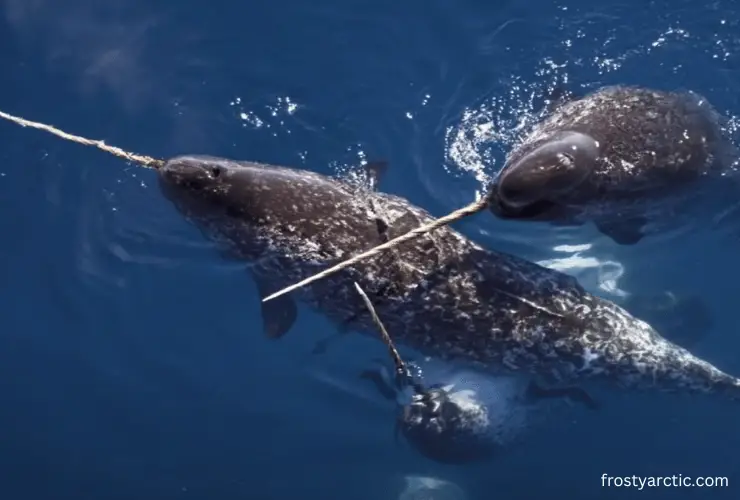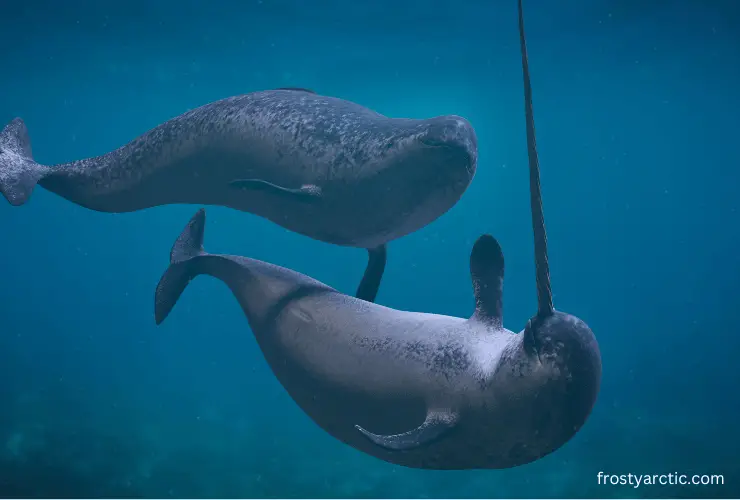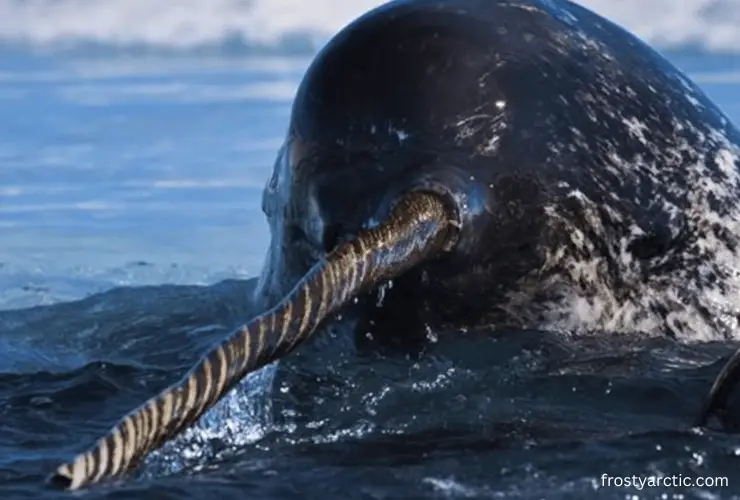Narwhals, a unique type that is a blend of a whale and a unicorn, are still around as of the current date. Still, you will find them in the Arctic zones around Russia, Norway, Canada and Greenland. There are more than 100,000 narwhals worldwide. But it is important to remember that some populations of narwhals, particularly in parts of eastern Greenland, are at serious risk of going extinct. It is “near threatened” as per the conservation status by IUCN.
All these statuses—threatened, endangered, or extinct—lead you to consider trying to identify the root causes of the issue. Plus, you look for the environmental adaptation of the species you are talking about. Since narwhals are a cold-water breed, human activity is a major factor in their poor conservation status.
Continue reading the column for a better understanding of the history of narwhals, their adaptations, and the factors that affect their way of life. So let’s explore together.
Are There Still Narwhals Alive?
The cold Arctic Waters of Russia, Canada and Greenland are home to narwhals. Yes, they are still alive, although they are on the status of near threatened.

According to the conservation status of IUCN in 2017, the narwhals were numbered above 100,000 and seemed to jump to the status of Least Concern from Near Threatened.
There are and have been multiple reasons for narwhals to improve their population status.
According to the research done by Danish scientists about the genetic diversity of narwhals, population variation has occurred from the past to this date. The co-author from the Natural History Museum from Denmark, Michael Westbury, claims that narwhals have evolved in terms of genetic diversity and increased population size. That may be one of the reasons they were able to adapt in the past and thus survive and remain alive.
Are Narwhals Endangered or Extinct?
Narwhals were designated as a near-threatened species by the IUCN in 2008. The study further said that over 100,000 narwhals were alive on the date, which could not be considered an endangered species on average.
Even in 2022, the status remains the same. They are neither extinct nor endangered, but they are close to both.
Conservation Status of Different Regions: Narwhals Extinction
The conservation status of different regions may differ. Like in Greenland, there is a fear of narwhal extinction between 2025-2028.
Measures taken to keep them below the status of endangered are listed below:
- Anybody who wants to trade narwhal parts and derivatives requires export permits under the Convention on International Trade in Endangered Species of Wild Fauna and Flora (CITES).
- Narwhal parts can only be imported into the EU and US with a permit and in very limited circumstances. It is governed by European Union Wildlife Trade Regulations (EU WTR) and the U.S. Marine Mammal Protection Act.
The narwhal is also listed in Appendix II of the Convention on International Trade in Endangered Species of Wild Fauna and Flora, according to the IUCN Red List assessment from 2018.
Why Is the Narwhal Going Extinct?
A marine mammal biologist at the University of Washington’s Polar Science Center, Kristin Laidre says that the whales have pack ice habitat in winters and we wonder where they will go if the ice isn’t present where it generally is present.
Although the theory explaining how narwhals behave in response to climate change is complicated, it can be summed up by saying that narwhal survival is, in fact, being negatively impacted by global climatic changes. They are creatures of habit, but they are also survivors. Living in an extremely cold environment is itself a surprise.
Narwhals postpone their migration from northern to southern regions as a result of the untimely and rapid melting of ice.
And then the sudden freezing of the seawater layer due to wind shifts or sudden temperature drop in the area would trap the narwhals in ice cracks.
These generally confined areas create entrapments for the narwhals, often suffocating them to death in large numbers.
What Threats Do Narwhals Face? Top Reasons for Narwhals Declining

Climate change is the main danger to narwhals, as mentioned above. And on a larger scale, it is not just the melting ice that causes their lack of food. It causes bigger things, like entrapment in ice cracks and suffocates them to death.
3 Common reasons for narwhals decline
Here is how we can list down some major hurdles causing narwhals serious survival threats:
- Climate change has disturbed the migration patterns of narwhals, which causes entrapments of narwhals in ice cracks.
- Oil and gas development has led to increased shipping. This creates noise pollution in the water. And narwhals need more communication among their breed. This disturbs the movement and food search of the narwhals.
- Indigenous hunters in Greenland and Canada have become a serious threat to narwhals. They are hunted for their unique tusks. Plus, the Mattak (narwhal skin) has achieved a special place in the international market as a hunting product since 1982.
When Will Narwhals Go Extinct?
Narwhals have been under threat of extinction for the reasons discussed above. A study on narwhal hunting shows an argument between hunters and scientists about whether to ban hunting or not.
There are currently no more than 600 narwhals in any of the three narwhal hunting areas in east Greenland: Ittoqqortoormiit, Tasiilaq, and Kangerlussuaq Fjord.
Mads Peter at the Institute of Natural Resources says that hunting can lead to the disappearance of the stock, so soon.
Here are some random observations I caught below:
- The percentage of pregnant narwhals caught has dropped since 2011 and reached zero in 2017, which means that the hunting area has no more of them.
- Without the ban, the likelihood that narwhals will go extinct by 2025 is almost 30%, and that likelihood will increase to 74% by 2028. This calls for East Greenland.
How Many Narwhals Are Left in The World?
The discussion shows that the narwhal’s threat of being endangered has been the talk of the town for ages. This is due to hunting and climate change. The population of narwhals keeps decreasing and increasing.
As per the conservation status report by IUCN done in 2017, the estimated population was between 170,000 and 123,000 mature individuals.
The Canadian Arctic is home to more than three-quarters of the world’s narwhal population, which is around 80,000. The number of narwhals is the largest in Baffin Bay and Hudson Bay, Canada.
How Can We Save Narwhals from Extinction?

With a clear idea of the threats to the narwhal population, the saving tips can easily be listed down:
- The International Whaling Commission regulates whaling to improve whale protection.
- The narwhals have satellite tags to track their movements and provide better care.
- The World Wildlife Fund is partnering with the Natural Resource Defense Council and Ocean Conservation Research to help reduce noise pollution in the ocean for ocean life.
FAQs
Who kills narwhals?
The natural predators of narwhals are polar bears, who kill them in breathing holes. Orcas are the second killer animal for narwhal pods. They attack and kill over a dozen in one go.
Why are narwhals important?
Among variousfactors is the balancing of the food chain by the narwhals as a top ocean predator. They serve as climatic change indicators, and having satellite tags allows researchers to learn more about the Arctic environment. They also have cultural significance due to their tusks.
Why are narwhals hard to find?
Narwhals are inhabitants of remote sites in cold Arctic waters. Plus, they live under ice covers in rather deep waters. Because of their migratory behavior, their mobility and speed make it challenging for observers to locate them.
Conclusion
According to recent findings, narwhals are not considered an endangered species. However, it is important to keep up with the specific actions that have been taken in the past. Strong controls are also required for climatic changes and human activities that pose a serious threat to marine life. One of the most unique marine animals should have its place among the non-endangered species.

